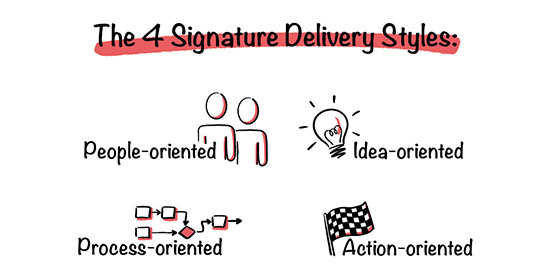
Developing a Signature Style
Often when we think of style, we think of what we wear and how we present our outer selves to the world. Developing your signature style for giving a presentation is similar because you’re not only presenting your topic but also yourself and your unique way of communicating. Your signature style is an external expression of your character and personality and is reflected in how you present—whether you’re an energetic extrovert who can bring down the house or a soft-spoken introvert with a calm demeanor and a knack for delivering just the facts. Tapping into your best attributes will power you through to presentation success.
Signature delivery styles generally fall into one of four categories: people-oriented, idea-oriented, process-oriented, or action-oriented. Some of these styles make emotional connections with an audience, whereas others persuade by using facts, analysis, and data to make the case. For example, if you’re a people-oriented storyteller, you may excel at tugging at your audience’s heartstrings. If your style leans toward the innovative idea-oriented, you may find success collaborating and brainstorming with others. Maybe you’re great at distilling your message into easily digestible pieces; then your style is more process-oriented. An action-oriented style focuses on achieving objectives and results; it helps get the job done.

Whatever your style, make sure it’s audience appropriate. You don’t want to talk over your audience’s level of understanding nor appear condescending. Always remember the end goal: you’re presenting your message to solve a challenge, concern, or problem. Remain flexible with your style and adapt it as necessary. There are times when you may be required to adjust your delivery to fit the content of your presentation or your audience. If your signature style is casual, lighthearted, loud, and funny and the content of your presentation is more serious, tone down your delivery. For example, if you’re giving a eulogy or your presentation is about the scourge of drunk driving, chances are you’re not going to crack a joke. Knowing your presentation content as well as your audience are paramount considerations when it comes to your signature delivery.
This chapter looks at distinctly different examples of presenters, including Anne, with very different but equally effective signature styles. These examples show the full spectrum of signature styles from energetically extroverted to introspectively introverted to grace under pressure. The styles reflect the presenters’ individual personalities, which they all use to their great advantage.
By developing a signature style, you’ll be reinforcing connections with your audience. At the same time, you’ll be improving your ability to read the room so you can deliver your message appropriately and meeting your goal of informing, instructing, entertaining, or persuading.
YOUR STYLE IS YOUR PERSONAL BRAND
Your style is largely based on your personality, relatability to the audience, and ability to engage an audience. It’s your calling card and your reputation is based on it. Your signature style of presenting will grow from your personality and evolve from there, and, as already mentioned, you’ll learn to adapt it depending on your content, situation, and audience. Presenting with a style all your own helps you convey your messages as well as make positive, memorable impressions on your audience. You can be one of the smartest people in the room, but without relating to your audience, you risk losing your credibility with them. Simply put, engage your audience with your style regardless of the content you’re presenting or you’ll lose their attention.
Think of the four styles mentioned: people-oriented, idea-oriented, process-oriented, and action-oriented. Which of these speaks to you the loudest or feels the most comfortable for you? It’s got to feel good to look good. Knowing yourself well is important when developing your signature style. When thinking about the kind of style you have, it’s also helpful to understand your ability to build relationships and be approachable. As the subject matter expert doing the presenting, you want your audience to come to you with questions, comments, and concerns. You don’t want to appear intimidating or that you want to get off the stage as quickly as possible.
Not sure which of the styles you lean toward? Try videoing yourself or ask someone to video you as you present; then ask a trusted friend or colleague to gently critique your performance. Coaches are also available who specialize in helping presenters by giving constructive feedback to help you refine your style and method of presenting. It’s a worthwhile investment if you plan to make a career in presentations.
AN EXAMPLE OF SIGNATURE STYLE AND BRANDING: TIME BLOCKING WITH A SMILE
SIGNATURE STYLE PERSONIFIED
Dr. Sam Adeyemi, author of Dear Leader: Your Flagship Guide to Successful Leadership, never thought he would take the world stage with his presentations, but that’s exactly what happened. In fact, he’s a self-professed introvert who has been building an international movement since he was a young man in Africa.
With his warm smile and engaging welcome, his signature style presentation emits his approachability and relatability. Both are powerful presentation tools that have taken him to hundreds of countries, inspiring tens of thousands of people to build a better world by beginning with themselves, their values, and their own daily behaviors and treatment toward others. He not only asks this of his audiences; he requires it from himself and his teams. If you ask, he’ll tell you this is all an organic and natural expression of his belief in a better planet and one humanity.
The point here is that his signature style drives his presentations, and to a large degree, his personal and professional success. His style is soft-spoken but powerful, and that’s hugely impactful for his audiences. In online and in-person deliveries, his consistent and genuine approach displays his ability to gently but convincingly convey a message of values-based leadership. Throughout this chapter, we’re using Dr. Sam, as he’s called, as an example to demonstrate just what a signature style is and can look like.
YOUR SIGNATURE STYLE IN ACTION
Like Dr. Sam, you demonstrate your signature style with every presentation you deliver, through your tone, words, attitude, gestures, and even the content of your messages. For instance, in the “fireside chats” he posts on his social media, Dr. Sam leans slightly forward in his chair and speaks softly, projecting his warmth and authenticity as he shares his message of leading with positive values. His presentations instruct others to teach their followers’ followers to become leaders as they move upward and onward in the spirit of “pay it forward.” His presentation style exudes the same personal ideals he holds dear, and is an expression of his positive attitude, work ethic, character, and core values. The way he sees it—and we do, too—the job of a powerful presenter is to bring out the best in others so they can achieve success, in whatever form it takes.
CUSTOMIZE YOUR STYLE FOR EVERY PRESENTATION
As noted, you may encounter times where you need to adjust your style to be sensitive to the content, audience, or medium you are using to present. This customization requires a little flexibility, creativity, and even personal evolution on your part. As you develop your presentation skills, you’ll grow your understanding of and experience in how to read your audience and customize your style with minor adjustments when appropriate.
Dr. Sam’s style has developed over time and geography. Starting with humble beginnings in a small African village, Dr. Sam began his career as a presenter by serving as a minister to small groups near his home. He later established a school for leadership, and he now presents in more than 130 countries to more than 400,000 attendees at premiere events like the Global Leadership Summit. Over the years, he learned the value of customizing his delivery to his audience and adjusting his messaging—but not his energy—to fit the audience, venue, and medium in which he’s presenting. You can visit him at GlobalLeadership.org or SamAdeyemi.com.
Keep Your Style (and Cool) Even in the Most Challenging Situations
Even the most easygoing presenters can get rattled when delivering a presentation. Early in Anne’s speaking career, she was presenting for a small business group. Before she took the stage, attendees were treated to an open bar. By the time Anne took the stage and began her presentation, attendees were still enjoying dinner and drinks . . . many drinks.
Earlier that day, she had also participated in a controversial business interview on a popular radio talk show, and she knew that some people in the audience might have listened to the interview and had different opinions on the topic.
A man in the first row, who probably had been overserved, started heckling her just after she began her presentation. He loudly shouted a few insults at her, which Anne ignored. In the blink of an eye, she felt something hit the lapel of her white silk suit—it was a tomato from this man’s entrée. The room went silent. Then, cool and collected, Anne looked down at the stain on her suit. She paused, swiped her index finger over where the tomato had hit her shoulder, scooped a morsel off her jacket, and dramatically tasted it.
“Hmmm. Needs more salt.”
The silent crowd now roared with laughter, breaking the awkward tension. The chairman and cochair “escorted” the drunk man from the room.
By staying calm and using decorum, Anne turned the tables on the heckler and then took and kept control of the room. Although the situation was embarrassing, she let the audience take care of the situation and continued her presentation to a standing ovation.
OTHER SIGNATURE STYLE TIPS
There are several universal truths spanning all signature styles that point back to your main reason for presenting: inform, instruct, entertain, or persuade. Your style is how you deliver in a way that is uniquely you, and makes your message memorable. Use these tips for developing and demonstrating your style:
• Know your audience. Make sure your delivery is audience-appropriate. You’re not going to tell an off-color joke to a church group, and you probably wouldn’t explain the necessity of filing your income taxes to a preschool class. You want your presentation to be remembered for the right reasons. Take into consideration your audience’s age, education, culture, comfort level with the subject matter, and what need of theirs you are filling with your message. Tell an appropriate story that allows your message to be heard. Facts tell, stories sell.
• Connect with your audience. Forging a connection is key to your believability and to how well your message is received. You may be speaking to a room of 5 or 5,000 people, but you’re really just having a conversation. Approach your task as if you were speaking to one person. Focus on conversing with one person and then move to the next person; do so across the room. Read the room, and if your audience isn’t connecting with your message or is missing your point, you can momentarily pause and reconnect by reiterating your point. Approach your communication with a heart of service. Remember that you want to get it right, and not necessarily be right. There’s a big difference.
• Get to know your audience. Aside from connecting with your audience while you are on the stage, it’s also important to get to know your audience off the stage, too. One way to do this is with meet and greets, which are also great for audience connectivity. This can work in a variety of ways. Typically the evening before the presentation, there is a mixer or group gathering. As the presenter, it’s nice to attend these and meet your audience in person before the actual event takes place. You can also meet informally at a breakfast or by shaking hands with people at the door as they arrive or by releasing a brief looking-forward-to-meeting-you video a few days before your presentation. Any of these efforts will help cement your relationships as a friendly and approachable presenter.
• Keep it simple and sincere. Remember to keep it simple and sincere—our version of KISS. Authenticity and sincerity are key to audience connection. If your audience doubts your legitimacy, they’ll stop listening and you’ll lose all credibility. You don’t want to be perceived as insincere or, worst of all, fake, because perception is reality when the spotlight is on you. Communicate from both your head and heart by knowing your subject matter and by delivering your message with positivity and energy. Let go of perfection and aim for proficiency. You can only control what you say, act, or feel. Then practice, practice, practice.
• Emulate positive attributes of others. Think about memorable speeches you’ve heard. How did those speakers capture your attention? Would that same practice work for you? Emulate the spirit of someone you admire to help you get your message across—as long as it’s something you believe in and is authentically you, it will help you lock in your message. Practice storytelling in front of a mirror, your family, even your pet.
• Have your end goal in mind. Are you informing, instructing, entertaining, or persuading? What’s the emotion you want your audience to feel or the action you want them to take? Have a beginning, middle, and end to your story. Know your call to action and reverse-engineer your story with this in mind.
• • •
Just as the style of your clothes reflects your culture, personality, or mood, how you create and develop your signature style for your presentations is what will set you apart from others—and what will potentially help get you invited back to present again and again. Your style is your brand. How you adapt your delivery to fit the event influences how the audience receives and processes your information. But it doesn’t stop there. Ask yourself, “How will my audience respond to what I have to say and how I say it?” Their response becomes the real measure of your presentation’s success.
ESSENTIAL TAKEAWAYS
